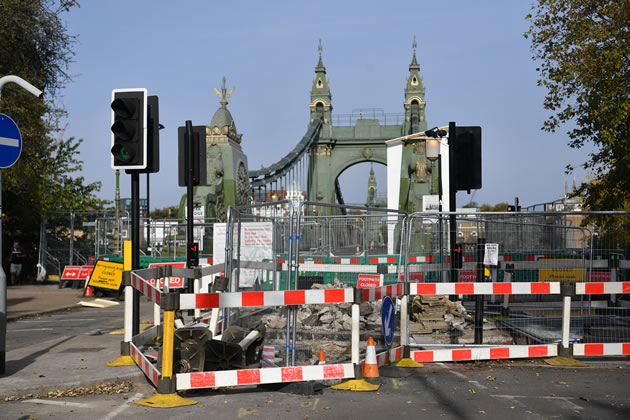Government Says Major Work Not Needed To Reopen Hammersmith Bridge
Claims Council and TfL have overstated risks to pedestrians and cyclists

The Government has said Hammersmith Bridge could soon reopen to pedestrians and cyclists, without needing “major works”.
The 133-year-old crossing closed to motor traffic in April 2019 when cracks were discovered in its cast iron pedestals.
The cracks widened during this year’s August heatwave, leading to a sudden decision to completely close the grade II*-listed landmark to cyclists and pedestrians, and even to river traffic passing under it.
This Thursday (10 December) reports on the bridge’s structural problems by engineers hired by the Department for Transport, (DfT) suggest the problems are not as severe as stated by Transport for London and Hammersmith and Fulham Council.
Council leader Stephen Cowan has consistently said the bridge is vulnerable to collapse. He challenged the DfT to confirm it would take legal responsibility for any consequences of reopening the bridge before carrying out strengthening works, which were expected to cost more than £40 million.
Mr Cowan said: “The suggestion that the bridge could be reopened… with little money spent on safety measures, has been the Government’s consistent position in Task Force meetings over past months. Our response has been to ask if they would take on the legal responsibility for such a decision, but they have consistently refused to do so.”
Engineering consultants AECOM and mechanics expert Professor Norman Fleck were hired by the DfT to review the work of engineers hired by the council and TfL. They argue that less significant work is needed to partially reopen it.
A statement from the DfT reads: “The reports recommend LBHF [the council] and its consultants reconsider whether the bridge can be reopened…
“Further mitigation measures will be needed. These include blast-cleaning the paint from the two remaining pedestals so that any hidden fractures can be identified, as well as potentially installing further monitoring equipment.
“AECOM and Fleck’s reports recognise that our understanding of the bridge’s condition and behaviour has improved considerably since March of this year when the current risk assessment was prepared.
“The Government is therefore calling on LBHF to review AECOM and Fleck’s work and consider their rationale for a full closure of the bridge, with a focus on exploring all avenues for a partial reopening.”
But the council maintains that assessments carried out by the “world-leading” engineers it hired would beg to differ.
“The bridge was closed because world-leading specialist engineers strongly advised the badly corroded suspension structure faced catastrophic failure. If the bridge collapsed, as they advised it could, it would have been a national disaster,” Mr Cowan said.
This new row comes after months of debate over who should pay how much for the repairs to the bridge – the council, TfL, or the DfT. The price tag for the full repairs has been estimated at £141 million.
Mr Cowan accused the Government of “political interference” and questioned why the DfT released information about the AECOM and Fleck reports before sending them to himself and other members of the Task Force.
“It’s fair to say that a number of Task Force members questioned the Government Task Force’s chair, Baroness Vere, about the professionalism of sending papers so late while spinning the story to the media well beforehand,” Mr Cowan said.
Owen Sheppard - Local Democracy Reporter
December 10, 2020